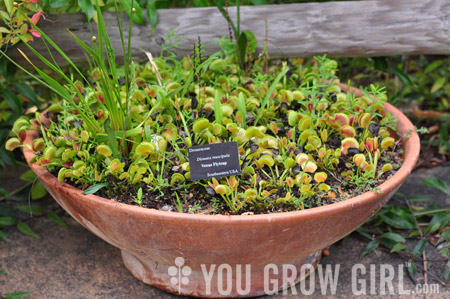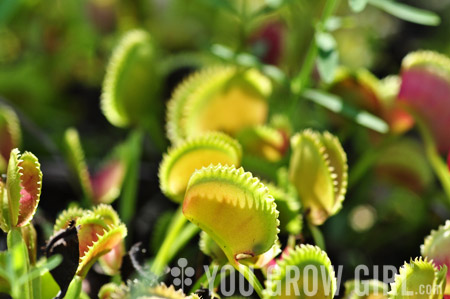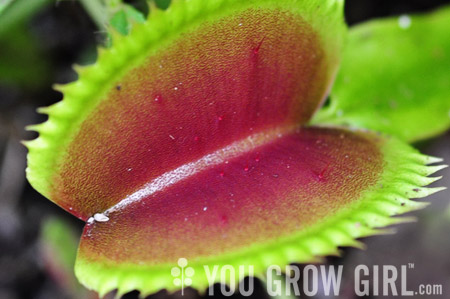
Every botanical garden has their forte, their special something that sets them apart from the others. Prior to any trip that includes a stop at a botanical garden, I tend to scour websites in anticipation of the sort of plantings I will see. However, before my trip to speak at the Atlanta Botanical Gardens last month, I decided not to do any research before hand. I thought it might be more fun to be surprised and wowed without the anticipation that comes with knowing what to expect.
Sure enough, I was absolutely giddy to discover that one of the garden’s claim to fame is their carnivorous collection! I have lots more to share with you, but first is a project that can be achieved at home.

Venus fly traps (Dioneae muscipula) are probably the most well-known carnivorous plant, and are widely available as impulse buys in big box stores and supermarkets. Yet, few of us get to really experience them beyond one small plastic shell packet in a cardboard counter display. The plants are marketed as an enigma, tend not to last long in our dry winter-heated homes and are a little bit intimidating as a result.
They’re a temperate-warm climate plant that prefers high humidity and can withstand short freezes, but can not survive the killing frost we experience here in the North. Venus fly traps love Toronto’s hot, humid summers, but require a chilly, but not freezing, winter dormancy period that fluctuates around the 50 degrees F mark. For this reason I have grown them as an annual in miniature bogs like the one shown above (photographed at the Atlanta Botanical Gardens) through the summer months, but tend to abandon them once the winter comes. In the right climate you can easily achieve the sort of mass planting shown in this bowl as the plants do reproduce readily and will even set seed.

Soil:
I’ve had a lot of luck using a mix that is 1 part sand, 1 part peat (substituting coir), and 1 part perilite.
Planting:
It wasn’t clear to me if the bowl (shown above) had drainage holes or not. In my experience, I have had best results growing venus fly trap outdoors in a pot with holes with a deep, water-filled saucer placed underneath to keep the soil moisture high, yet also allow for drainage through periods of heavy rainfall.
When drainage is not offered, I line the bottom of the bowl with gravel and keep the pot in a sheltered spot where I can control the amount of water it receives. Venus fly traps like wet conditions, but they can still become water-logged and rot if left permanently submerged in water.
————–
I cover growing a carnivorous bog in my first book, You Grow Girl: The Groundbreaking Guide to Gardening, and if you’d like to learn even more on growing all sorts of carnivorous plants, I highly recommend The Savage Garden: Cultivating Carnivorous Plants by Peter D’Amato.
The Carnivorous Plant FAQ has an detailed section on growing venus fly traps, including a few tricks for dealing with dormancy.
Love the bowl idea! We grew ours indoors in a terrarium.
I would love to try this! I’ve twice had venus flytraps in little pots but they never lived long. Glad of your tips.
Hi Gayla!
Our flytrap bowls do indeed have drainage holes. We site them in full sun and bring them indoors (i.e., in the greenhouse) for winter, since outdoor containers will freeze here in the winter.
had to laugh at the mention of ‘one small plastic shell packet …’ because it sounded like you actually knew the little pet that I brought home to die …
Have you been to the Darlingtonia State Natural Site? It’s a spot along the Oregon coast where pitcher plants grow wild. My first trip there, close to 20 years ago now, I saw some other carnivorous plants in the undergrowth – sundews, I think. When I was there most recently, 2-3 years ago, I couldn’t find any sundews. Not sure if the pitcher plant population exploded and crowded out the other plants or what happened.
Oooh, Venus Fly Traps! Interesting thing about those little buggers; I know people that grow them as a perennial here in central Illinois. We are zone 5b here, I know of 2 people here in my small rural town that have established, outdoor carnivorous plant bogs. Apparently the trick is to have them in a protected area and generously mulch them with straw in the fall. :-)
I live in the Toronto area and my family has a cottage up north (Parry Sound area). In a small shallow lake behind the cottage that is not used much by us humans, I discovered what appears to be lots of little fly traps. They are tiny, but seem to thrive on the marshy edges of the shallow pond. I have no doubt they thrive on the swarms of mosquitoes that live there. I would not have expected to find them growing wild up here, not sure if my untrained eye mistook them for something they are not, but they sure do look like the ones in the picture above!
Becky: Thanks for so much for weighing in on the bowls.
Beth: I have seen pitchers and sundews up north but not fly traps. Would love to see pictures if you have them!